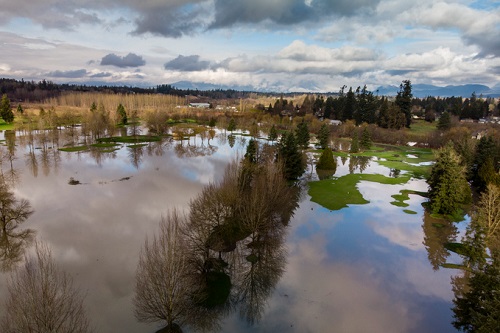How FloodFlash can help cover golf courses and country club

Authored by FloodFlash
April is Stress Awareness Month and whether working from home or amongst colleagues in the workplace, stress is a difficult, ever-present reality in today’s society, impacting us all in one way or another.
There are loads of examples of sectors underserved by the flood market, but nothing gets the insurance community fired up like golf! And given The Masters Tournament is coming up we decided to show how we can cover even these neglected, more niche, risks by sharing our approach to golf course risks.
The problem with golf courses
When it comes to modelling flood losses, golf courses are almost as tricky as a risk can get. When establishing the hazard, there are several factors that make things tricky, including:
generally uneven terrain with varying elevation with (golfing) hazards and depressions,large surface areas that experience flood differently,coastal and riverside locations with higher risk of flooding,changing risk due to landscaping of the course.
While water features might add to a golf course’s charm, unwanted floodwater can cause significant damage and disruption.
That’s only half the challenge though, because establishing the vulnerability in terms of asset/BI value is equally as tough:
carts are often write-offs,sand from sand-traps or coastal courses contaminates the course leading to extensive cleanup,debris removal and drainage can be expensive and time consumingrecovering the well-maintained tees and greens adds to (or multiplies) the cost.
All these factors combine to make golf courses VERY difficult to provide reliable insurance prices using traditional methods. That’s why many of the partners we visit have a golf course risk they are keen to find coverage for. They simply can’t get the right limits on the traditional market.
Even Augusta isn’t immune. In 1990, the home of the Masters Tournament flooded when water from Rae’s Creek hit Amen Corner hard, destroying the 11th green and the member’s tee at the 13th. It took one of the best grounds teams in the world 6 weeks of extensive effort to repair the damage.
How is FloodFlash able to help?
FloodFlash uses known sensor locations to trigger a flood claim. This means that the hazard and vulnerability equation is much more manageable for our expert underwriters, leading to reliable, flexible pricing for any golf course location.
Golf course clients can place their sensors on main clubhouse or outbuildings like halfway huts or groundsman structures. They can also install permanent posts to which the sensor can be attached. They can also use several sensors to account for different risks across a course. It’s a new and powerful way to provide coverage to the courses we love.
Why choose FloodFlash for golf course flood coverage?
The primary reason is to secure limits that aren’t available on the traditional market. But there are plenty more reasons to consider FloodFlash over alternative flood providers:
Secure coverage for all financial exposures – tees and greens, golf carts, bridges, debris removal and sand clearance, change of location for tee boxes and greens, members’ club and outbuildingsBusiness interruption including non-damage/denial of accessClaims that get paid in weeks, not months – allowing for faster recoveryFloodFlash experts are on hand to support with sensor placement and triggersSite visits available on request
FloodFlash is already trusted by many prestigious golf courses and country clubs, including an Open Championship host. Got a golf club client that needs support? Get in touch and we’ll tee up some rapid payment coverage!
Download our FloodFlash Golf Course program guide





